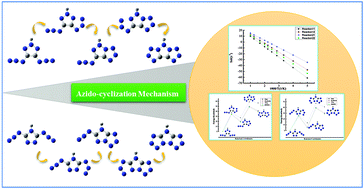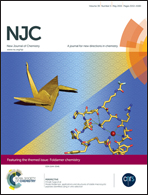A comparative theoretical study on energetic substituted 1,2,3- and 1,2,4-triazoles: the azido-cyclization mechanism and the effect of solvent†
Abstract
The hybrid DFT calculations with B3LYP/6-311G* level of theory have allowed us to gain insight into the azido-cyclization of 4,5-diazido-1,2,3-triazole and 3,5-diazido-1,2,4-triazole and the effect of solvent. The optimized geometry, charges and molecular electrostatic potential were calculated and the results indicate that the cyclization occurs mainly in the conversion azido → tetrazole, in which the molecular and electronic structures change more significantly. Further analysis of the energy parameters indicates that all possible reactions are endothermic and not spontaneous in the gas phase, but the first and second azido-cyclization of 3,5-diazido-1,2,4-triazole could be performed theoretically with energy barriers of 26 kcal mol−1 and 33 kcal mol−1. Again, the rate constants and the Arrhenius experience formula of azido-cyclization have been obtained between 200–1000 K temperature regions. In addition, the solvent effect on azido-cyclization was studied with acetone, trifluoroacetic acid and dimethylsulfoxide. The results show that the solvent effect can make the intermediates and products more stable than in the gas phase. The energy barriers for the first and second cyclization are lowered more or less especially in dimethylsulfoxide, and the influence on the azido-cyclization of 4,5-diazido-1,2,3-triazole is a little larger.


 Please wait while we load your content...
Please wait while we load your content...